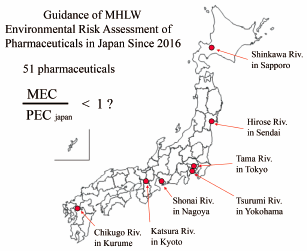1 0 0 0 OA Environmental Risk Assessment of Active Human Pharmaceutical Ingredients in Urban Rivers in Japan
- 著者
- Toshinari Suzuki Yuki Kosugi Kimiyo Watanabe Haruka Iida Tetsuji Nishimura
- 出版者
- The Pharmaceutical Society of Japan
- 雑誌
- Chemical and Pharmaceutical Bulletin (ISSN:00092363)
- 巻号頁・発行日
- vol.69, no.9, pp.840-853, 2021-09-01 (Released:2021-09-01)
- 参考文献数
- 70
- 被引用文献数
- 5
Active pharmaceutical ingredients (APIs) have become a public concern owing to their possible adverse effects on aquatic organisms. Ministry of Health, Labor and Welfare in Japan (MHLW) issued “Guidance on the Environmental Risk Assessment (ERA) in new pharmaceutical development” in 2016. To evaluate the validity of phase 1 in the MHLW’s ERA guidance, we monitored the measured environmental concentrations (MECs) of approved APIs in urban rivers and sewage treatment plants (STPs) in Japan and compared these MECs with the predicted environmental concentration (PEC). We collected water samples from urban seven rivers and three STPs during each season. Fifty-one APIs for human and veterinary use and the artificial sweetener sucralose were analyzed by liquid chromatography-tandem mass spectrometry (LC-MS/MS). Forty-four APIs were observed in the rivers and 42 were found in the influent and effluent of STPs, with levels ranging from nanograms to micrograms per liter. The action limit in phase I of the MHLW’s guidance was set to 10 ng/L, and there was no API except for ketoprofen, for which PEC of the MHLW’s guidance (PECjapan) was lower than 10 ng/L and the maximum MEC (MECmax) was 10 ng/L or greater. Almost all APIs also had median MECs that were lower than those of the respective PECjapan. These results indicate that the PECjapan values in phase I of the MHLW’s guidance were appropriate. However, some APIs had MECmax values that were greater than those of the respective PECjapan due to overestimation of the dilution factor of river water and/or underestimation of API production.
- 著者
- Atsuya Takagi Akihiko Hirose Tetsuji Nishimura Nobutaka Fukumori Akio Ogata Norio Ohashi Satoshi Kitajima Jun Kanno
- 出版者
- The Japanese Society of Toxicology
- 雑誌
- The Journal of Toxicological Sciences (ISSN:03881350)
- 巻号頁・発行日
- vol.33, no.1, pp.105-116, 2008 (Released:2008-02-26)
- 参考文献数
- 22
- 被引用文献数
- 428 655
Nanomaterials of carbon origin tend to form various shapes of particles in micrometer dimensions. Among them, multi-wall carbon nanotubes (MWCNT) form fibrous or rod-shaped particles of length around 10 to 20 micrometers with an aspect ratio of more than three. Fibrous particles of this dimension including asbestos and some man-made fibers are reported to be carcinogenic, typically inducing mesothelioma. Here we report that MWCNT induces mesothelioma along with a positive control, crocidolite (blue asbestos), when administered intraperitoneally to p53 heterozygous mice that have been reported to be sensitive to asbestos. Our results point out the possibility that carbon-made fibrous or rod-shaped micrometer particles may share the carcinogenic mechanisms postulated for asbestos. To maintain sound activity of industrialization of nanomaterials, it would be prudent to implement strategies to keep good control of exposure to fibrous or rod-shaped carbon materials both in the workplace and in the future market until the biological/ carcinogenic properties, especially of their long-term biodurability, are fully assessed.
